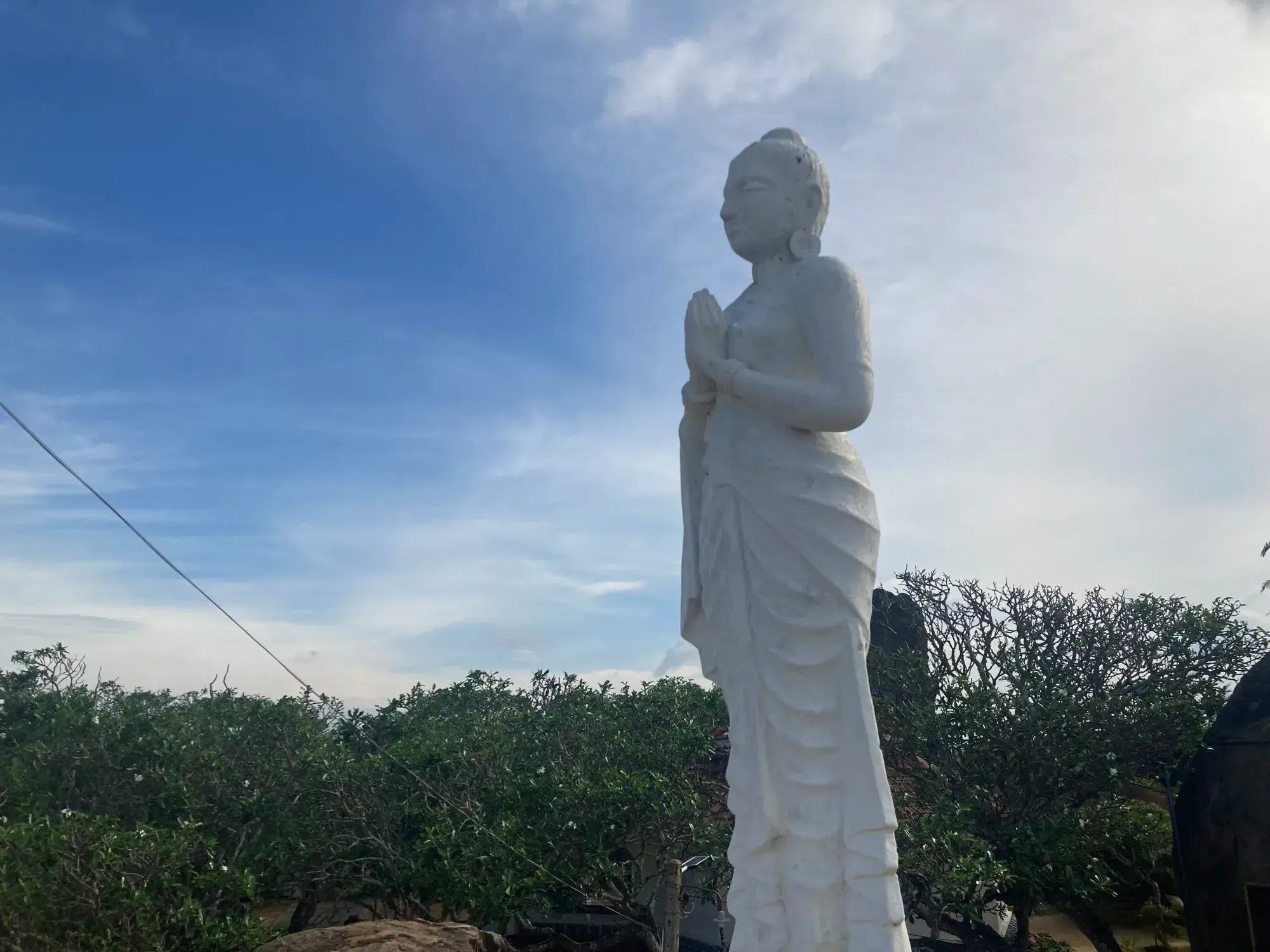
Kirinda Vihara Maha Devi Temple
History of Kirinda Vihara Maha Devi Temple
The Legend of Queen Viharamahadevi
Kirinda Vihara Maha Devi Temple is connected to a significant story from Sri Lanka’s ancient past. In the past, Sri Lanka was divided into several small kingdoms. King Kelanitissa ruled the kingdom of Kelaniya, near present-day Colombo. According to legend, Kelanitissa executed a Buddhist monk, believing him guilty of treason. People at the time believed this grave injustice caused the gods to become angry, leading to catastrophic flooding by the sea, likely a tsunami.
To appease the gods and end this disaster, the king was advised to offer his own daughter as a sacrifice to the sea. His brave daughter, Princess Viharamahadevi, willingly volunteered to save her people. She was set adrift alone in a golden boat on the stormy ocean. Miraculously, the boat safely landed near Kirinda, located in the southern kingdom of Ruhuna.
King Kavantissa, the ruler of Ruhuna, discovered the princess and was deeply impressed by her bravery and noble spirit. Recognizing her courage and royal lineage, he welcomed her and eventually married her. Viharamahadevi became celebrated not only for her bravery but also as the respected queen who would later bear King Dutugemunu, one of Sri Lanka's most famous and revered historical rulers. King Dutugemunu is renowned for unifying the island and advancing Buddhism.
Temple Origins
To commemorate the miraculous landing of Princess Viharamahadevi and honor her courage, King Kavantissa established a temple at Kirinda. He chose a dramatic location atop a cliff overlooking the ocean, marking the exact spot where the princess’s boat came ashore. The white stupa built at this location still stands as a prominent symbol of gratitude and reverence.
Cultural and Religious Significance
Kirinda Temple remains an important place of pilgrimage for Buddhists. The site symbolizes courage, divine protection, and devotion. The temple uniquely houses both Buddhist and Hindu shrines, emphasizing Sri Lanka’s tradition of religious coexistence. Its elevated location also played a crucial role during the 2004 tsunami, providing refuge and further enhancing its spiritual significance.
Architecture and Features
Statue of Queen Viharamahadevi
One of the prominent features at Kirinda Temple is the serene and dignified statue of Queen Viharamahadevi. Carved with careful detail, the statue portrays the queen in a calm, reverent posture, paying tribute to her courageous act and historical importance. This statue serves as a focal point for visitors and pilgrims, symbolizing bravery, sacrifice, and noble heritage.
The White Stupa
At the temple’s highest point stands an iconic, ancient white stupa. Built by King Kavantissa, it symbolizes gratitude for the queen's miraculous survival and arrival at Kirinda. The stupa’s simple yet elegant design can be seen from miles away, offering a sense of serenity and sacredness. Visitors often circumambulate this structure in a respectful ritual, reflecting on its historical and spiritual significance.
Standing Buddha Statue
Adjacent to the stupa, a large modern Buddha statue overlooks the entrance to the temple. Standing tall and tranquil, the statue's graceful presence adds spiritual depth to the already profound atmosphere of the temple.
Additional Features
Visitors will also find several other noteworthy elements within the temple grounds. A sacred Bodhi tree offers a serene spot for quiet reflection and meditation. A beautifully decorated devalaya features intricate religious paintings and statues, providing deeper insight into local spiritual practices. On the rocky mountain peak, another smaller devalaya provides stunning panoramic views, making it an ideal location for peaceful contemplation.
Location and Scenery
Kirinda Temple offers breathtaking views of the Indian Ocean and surrounding landscapes. Visitors enjoy panoramic vistas of beaches, distant dunes, and even the Great Basses Reef Lighthouse. Inland views reveal the lush plains of Tissamaharama, especially picturesque at sunrise or sunset.
Best Time to Visit
While the temple is open from dawn to dusk, the best visiting times are early morning or late afternoon. These periods offer more comfortable temperatures and ideal conditions for photography, avoiding the intense midday heat.
Tips and Advice
- Dress respectfully, covering shoulders and knees.
- Carry drinking water and sunscreen.
- Respect local customs, especially regarding photography.
- Exercise caution around cliffs and uneven terrain.
Nearby Attractions
- Kirinda Beach: Beautiful and rugged beach located right next to the temple, ideal for walks and enjoying coastal views.
- Yala National Park: Renowned for wildlife safaris, especially leopards and elephants.
- Tissamaharama Ancient City: Famous for historical stupas and scenic lakes.
- Kataragama: Significant pilgrimage site for Buddhists and Hindus.
- Bundala National Park: Excellent birdwatching and wildlife viewing.
- Great Basses Reef: Noted diving site featuring shipwrecks and vibrant marine life.
A journey to Kirinda Vihara Maha Devi Temple immerses visitors in captivating legends, serene spirituality, and stunning oceanic vistas, making it a genuinely enriching destination on Sri Lanka's southern coast.
